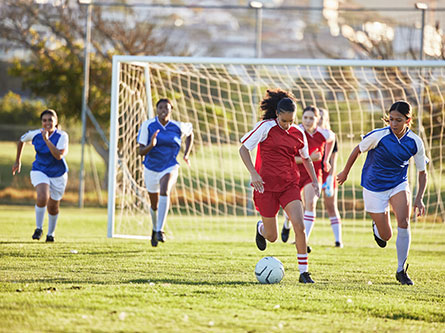
As fall soccer season ramps up, many athletes are preparing to compete at their best. For athletes to stay on the pitch, they need to avoid injury.
Sports medicine orthopaedic surgeon Christopher Bayne shares insights on common soccer injuries. He also gives tips to avoid injury and get back out there if you or your child gets hurt playing soccer.
What are some injuries that soccer players are prone to?
Soccer is a sport where most injuries occur in the lower extremities. These injuries usually involve the knee, ankle and hamstring. They can range from bruises or strains to fractures or ligament tears.
However, injuries to any other body part are also possible. For example, soccer players can suffer injuries to the hand, elbow, or shoulder. Head impact with the ground, ball, or other players can lead to traumatic brain injury (TBI) or concussion.
Explore 7 common youth sports injuries and ways to prevent them
Learn how to spot a concussion and what to do if you suspect a brain injury
Are male or female players more likely to be injured in soccer?
The chance of injury among soccer players differs across level of play, age, and sex. There's some evidence that males are more likely to be injured playing soccer. However, both males and females are at risk for injury.
The frequency of certain types of injury differs between men and women. Several studies have shown that male players have nearly twice the rate of hip and groin strains. Female players suffer much higher rates of knee injury and anterior cruciate ligament (ACL) tears.
There are many reasons for these differences. But experts believe they are partly due to anatomy and strength differences between men and women.
How can players and coaches minimize the risk of injuries in soccer players?
Injury prevention in soccer can and should take several forms. They include the following:
- Prepare well before games. This includes warmups, stretching, and staying hydrated.
- Wear the right protective gear, such as shin guards.
- Ensure safe playing conditions. One example is the use of padded goals, which can decrease the risk and severity of head trauma.
- Take regular breaks during play and cross-training to help prevent overuse conditions.
- Sport-specific exercises and training on proper technique can improve muscle imbalances. They can also prevent movements that may lead to injury.
What should soccer players do if they're injured?
Players who are hurt should stop playing immediately and assess their injury. Players may experience confusion as to whether their injuries need medical attention.
Minor injuries, such as sprains, may improve with rest, ice, compression, and elevation. However, players shouldn't be afraid to see a health care provider even if they think it might be minor.
Some symptoms that may require players to seek medical attention include:
- Significant pain or swelling
- Not able to move the injured body part
- Inability to bear weight or walk on the injured body part
- Pain isn't getting better with rest
- Concern that there is a serious injury, such as a break
If a player has a head injury, potential warning signs of concussion include:
- blurred or double vision
- light sensitivity
- eye strain
- abnormally sized or uneven pupils
- abnormal eye movement
- trouble focusing
- confusion
- loss of consciousness
Learn how to spot a concussion and what to do if you suspect a brain injury
If any of these signs are present, the player should be seen by a medical professional.
What are the guidelines or recommendations for returning to play after an injury?
A player who received medical attention for injury should not return to play without being cleared by their provider.
In general, the risk of re-injury is much less if all symptoms have cleared before returning to play. This includes no pain or swelling, normal strength and full range of motion.
Patients with brain trauma or a concussion should have no symptoms before returning to play. They should also pass post-concussion testing and be cleared by a medical professional.
What kinds of injuries do UC Davis Health providers typically see in soccer players?
We have an excellent team that can diagnose and treat all types of soccer injuries. We see lower extremity injuries often since these are the most common type of injuries in soccer players.
While upper extremity injuries are less common, our providers treat players with these injuries. These include hand and wrist fractures, as well as ligament, tendon, or cartilage injuries of the shoulder and elbow.
Check out our Department of Orthopaedic Surgery
Explore what we offer in the Department of Sports Medicine
This blog was written by sports medicine orthopedic surgeon Christopher Bayne, M.D.




